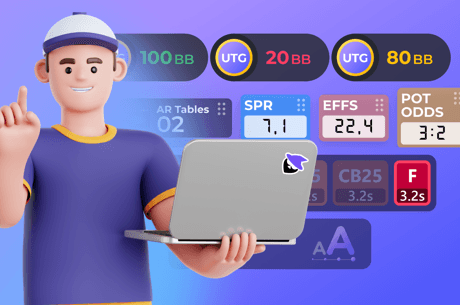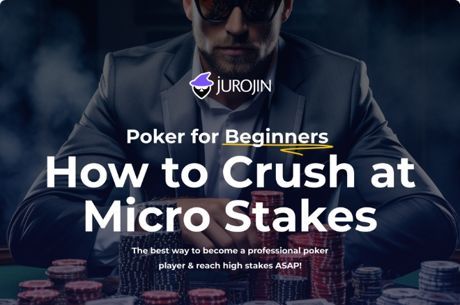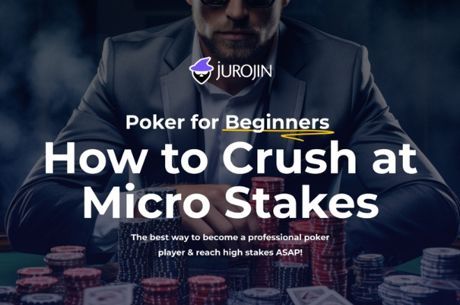The Outs That Weren't There; or, How Not to Play a Drawing Hand Online

Here is another real poker hand with real players mashing virtual buttons for real monies. The game once again is six-handed no-limit hold'em cash, played online at $0.50/$1 (100NL). Like others we've reviewed, this one presents a lesson in what not to do when playing online poker — in this case one having to do with being too aggressive when playing a drawing hand from out of position.
A regular opens the pot from middle position to three times the big blind ($3). It folds around to the big blind, your average player having a good time on a Monday night, and he calls. The effective stacks are 120 big blinds deep. The flop comes A♦9♣3♣.
All boring, until…
A Rare Branch of the Game Tree
The big blind checks, the initial raiser continuation bets $3, the big blind check-raises to $7, then the regular makes it $23 to go.
With what hands should the middle position player be doing this? What can the big blind do to respond?
The big blind calls the $23. Let's see what happens next.
More (Alleged) Draws on the Turn
The turn is the 3♦. So we have two clubs, two diamonds, and a paired board. Also, anyone flopping bottom set just got a lot more unlikely.
One of the reasons it's tough for the big blind to check-raise this flop is that, well, the big blind doesn't have the strongest hand — AxAx — and might not have the strong aces, either, i.e., AxKx and AxQx.
On the other hand, a recreational player could defend with hands like Ax9x and Ax3x — hands the regular might decline to play. So that's what the big blind is representing.
All that is rendered slightly irrelevant when the initial raiser responds to the check-raise with a reraise — and a big one at that to $23. Now he is claiming he has a set. The hand that probably makes the most sense for him to do this with is 9x9x — he doesn't block any ace in the hand of the big blind and he has a big interest in building a pot.
To see a bluff here in an online 100NL game is pretty rare — don't expect it.
Now our big blind is in a tough spot with just about any hand he could hold. If he check-raised 5x4x, he is going to be shut out of the pot. Meanwhile any flush draws have been laid a bad price, out of position, to continue, and his value hands might not be best anymore.
The big blind has two choices on the flop — fold or (stubbornly) call. If he responds by reraising back, he is going to run into a set way too often.
Of course the turn changes things for the worse. Our big blind's possible draws are now crushed. But, I suppose, he might not know that. Especially when it goes check-check, as it did.
Action Card
The river was the 7♣, completing the club flush draw. There is $52 in the middle with $94 behind. If the big blind thinks the flop reraise might have come from AxKx or AxQx, I suppose leading out now with flushes and Ax9x or Ax3x hands makes sense to prevent his opponent just checking behind. Well, the big blind did lead out, betting $25 into the $52.
Then his opponent went all in for $69 more.
All Questions Answered
Now the cat is out of the bag. (Where did they get that phrase from, anyway?)
We didn't know what the initial raiser was reraising the flop with to check this turn, until now. If he got frisky with AxKx or AxQx, he would have a river decision either to call or fold. Raising makes no sense with these hands since they beat bluffs and lose to value bets.
Therefore he either reraised the flop with A♣X♣ (top pair and the nut flush draw) or with something that boated up on the turn making him unafraid of giving a free card — e.g., AxAx, 9x9x, Ax3x, or the rare 3x3x.
The big blind again is in a really tough spot with hands like Ax3x and 9x9x. Ultimately, in order to prevent being exploited, the big blind should probably call these off. Sometimes he'll win versus a flush, and sometimes he'll get stacked by better full houses. With your strongest hands, that's unavoidable occasionally.
What he shouldn't do is ignore all the warning signs and call off with a non-nut flush — which, as it happens, is what the big blind did with K♣5♣. He got bad news — his opponent had AxAx.
What Not to Do
All the problems here begin on the flop. The big blind can just check-call the flop, not check-raise. Doing that keeps a ton of worse hands in the pot, including all the initial raiser bluffs like QxJx and 8x7x, and doesn't expose the big blind to a hopeless situation.
The fact is, the big blind doesn't actually want to narrow an opponent's range to stronger hands when better flush draws are out there and he is out of position. Just calling the flop c-bet allows the big blind to see if he turns a pair on a king or a five, or picks up a gutshot with a trey or deuce. He doesn't only have to draw to the flush versus a weak range.
As it turned out — as will often happen, given this sequence of events — the big blind's "outs" were illusory. That's what is going to happen if you play a non-nut draw into a strong range that isn't slowing down. It's a sinking feeling when you see those two aces revealed.










